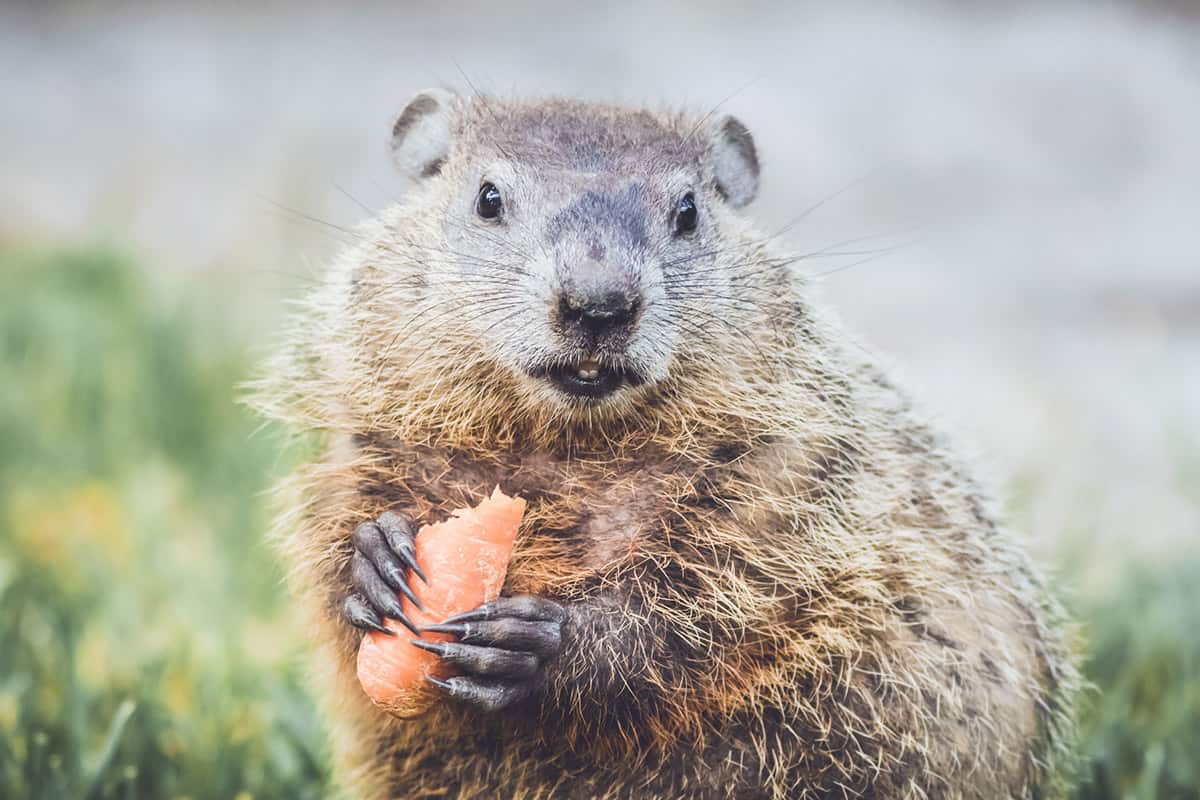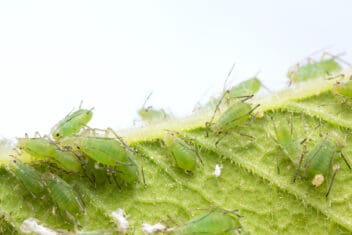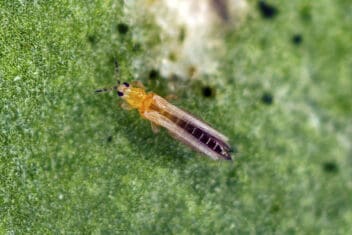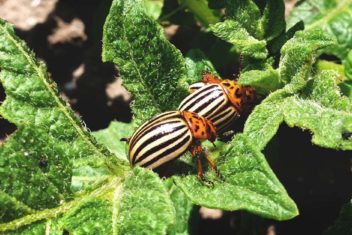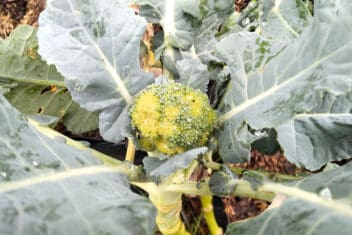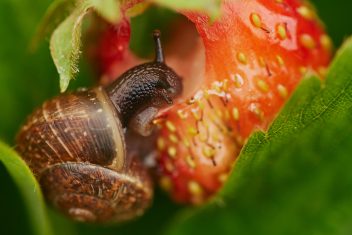Groundhogs are no joke; when they find your garden, you can kiss your harvest goodbye unless you have a solid plan to protect yourself from them.
This year, my in-laws didn’t have a plan, and the local groundhogs ate all of their green beans, tomatoes, and zucchini. While I do prefer groundhogs over raccoons because they won’t kill my chickens, losing your entire garden is heartbreaking.
What can you do? Let’s dig in.
What Are Groundhogs?
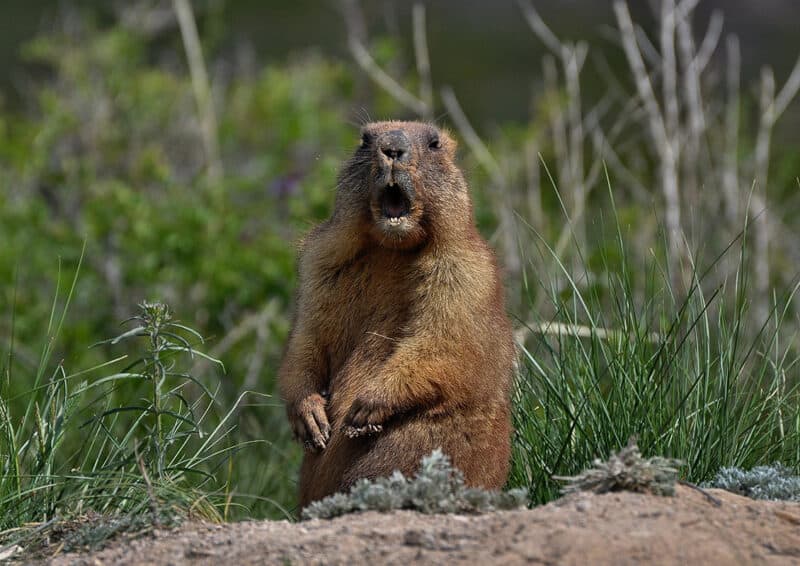
Sometimes referred to as woodchucks or marmots, groundhogs are a type of rodent that causes massive damage to your garden and lawn.
Groundhogs are a relative to squirrels, typically weighing 4-14 pounds with long, coarse, grayish-brown coats. You can find them in nearly every state, including Alaska.
As suggested by their name, these animals are excellent ground diggers; they can build extensive tunnel systems with chambers, hallways, and several exits. These burrows can be 2-4 feet underground, running up to 30 feet horizontally.
Due to their underground activity, groundhogs on your property can weaken the soil. That might not seem problematic, but it can damage the foundation under your barns and sheds or even your farming equipment. Plus, weakened soil is a danger to your livestock.
Groundhogs are herbivores, so while they won’t dine on your livestock, they will make your vegetable garden their four-course buffet. They can wipe out an entire garden in a matter of a day or two, so you have to pay attention.
Like many animals, groundhogs hibernate in their dens throughout the winter and emerge as the temperatures start to get warmer. Despite the Groundhog Day celebration on February 2nd, the rest of his family members are sleeping in their dens at this point.
They tend to be the most active in the spring when they start to mate.
Groundhogs are not nocturnal; they’re active during the day, which does help you stop them. It’s hard to catch nocturnal animals.
Signs of Groundhog Damage
Despite being active during the day, if you work outside of the home, you might not catch them in the act. So, how do you know that groundhogs are your culprit?
Here are some of the common signs left behind by groundhogs.
- You notice wide teeth marks left behind on the plants, fruit, and bark.
- You find burrow entrances next to piles of dirt throughout your property.
- There are deep burrow holes in the lawn.
- Look for tracks in the dirt that have 4-clawed toes on the front paws and 5 on the back.
Groundhogs Eat A Lot
You don’t get that cute and chubby – yes, the groundhogs on my property that don’t bother my garden are fat and adorable – by not eating. These babies love to eat and aren’t picky.
Groundhogs need to eat a pound and a half of vegetation each day. So, if you have a family that found your family, it’s easy to see how they can destroy a garden in days.
That doesn’t mean they don’t have favorites – they do. Here are some of their favorite snacks in your garden.
- Carrots
- Peas
- Broccoli
- Lettuce
- Green beans
- Squash
- Daisies
- Lilies
- Pansies
- Marigolds
- Sunflowers
Got any of these (or all of them) in your garden? It’s like a blinking welcome sign, encouraging the local groundhogs to stop by for a snack throughout the day.
Without protection, you might as well tell everyone you’re growing an all-you-can-eat buffet for the local groundhog population.
9 Ways to Protect Your Garden From Groundhogs
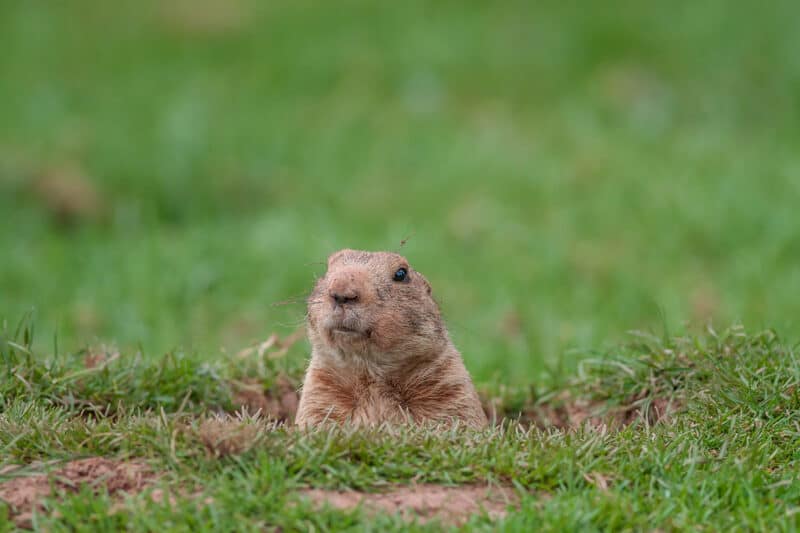
Keeping a dog can be helpful to keep out groundhogs, but not everyone wants to own a dog. You also can trap and release, but not everyone has the means to do so.
Ideally, since you’re working with your garden, you want to keep your prevention methods as organic as possible. You don’t want to hurt the environment or your family members.
So what options do you have? If you’re ready to kick your groundhog problems to the curb, here are some tips that you need to try.
1. Prevention is Key
Just like any rodent infestation, prevention is key. You have to take time to identify and remove whatever is attracting them. That might be a compost pile that has some of their favorite snacks or fruit scattered on the ground under your apple tree.
Brainstorm any methods you can think to prevent them from coming to those areas, but beware it doesn’t always work.
2. Fence Your Garden
One of the best prevention methods is to fence out the groundhogs, but realize that they can jump over short fences and tunnel under the rest of them.
If you’re going to build a fence around your garden to stop groundhogs, you have to do it the right way.
Here are some tips.
- Build them tall. The fences need to be made with five-foot-tall posts for the best results.
- Next, make sure you have chicken wire that is six feet tall and bury the wire 12-18 inches deep to stop them from tunneling under the fence.
- Then, attach the fencing to the post, but leave about a foot at the top that isn’t attached. With that foot of fencing remaining, bend it away from the garden, which helps prevent the rodents from climbing over the top.
3. Try Relocation
I understand that not everyone has the means or desires to catch and release groundhogs, but it’s a viable option that does need to be discussed.
Catch and release IS an effective method as well as being a humane choice. You aren’t killing them – just removing them from your property.
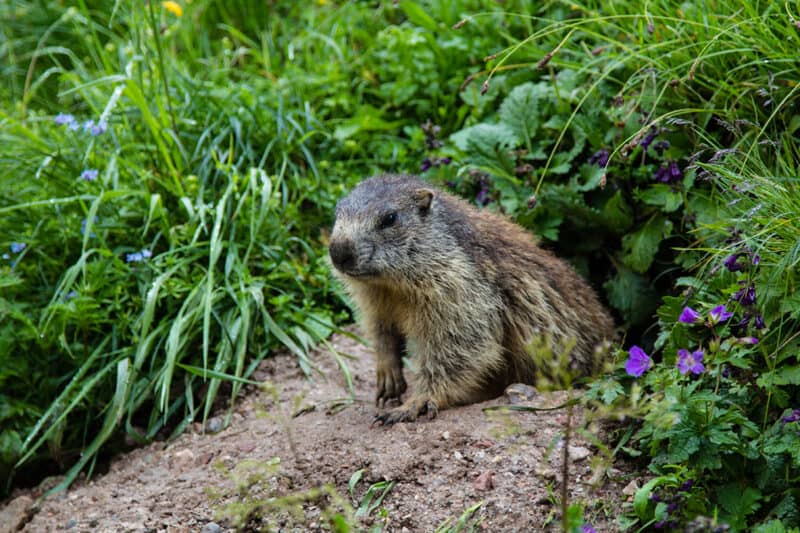
Set live traps 5-10 feet away from their burrows and add some bait. Think about what the groundhogs are eating in your garden and toss some of that in the trap.
Finding a place to relocate is the hardest part. Your local humane society or extension office can give you suggestions on where to release groundhogs. Some extension offices even have traps you can borrow.
4. Harvest Your Garden Often
Something else you can do to discourage them from destroying your garden is by harvesting often. They love to eat tender greens, like lettuce, along with green beans, cucumbers, zucchini, and other tummy snacks.
Don’t leave them in your garden! As soon as these crops are ripe, bring them inside from the garden.
5. Use Castor Oil
Groundhogs cannot stand the smell of castor oil; I can’t blame them! So, a simple solution to discourage their presence is to pour castor oil in and around the burrow holes. Just make sure you pour it in the area when you know that they’re not in the hole.
You can also make a repellent spray using 1 cup castor oil, 2 cups Murphy’s Oil Soap, 1 cup of the hottest hot sauce you can get your hands on (think ghost peppers), 1/4 cup human urine, and a gallon of water.
Spray this on any plants that the groundhogs like to visit.
6. Sprinkle Hair Clippings
Whether you want to ask a local barber or trim a few of your kids’ hair, groundhogs don’t like the scent of humans. So, sprinkle the clippings in the areas that groundhogs frequent the most.
The problem with hair clippings is that they blow away in the wind. So, a solution can be to put clippings in a mesh bag and secure them in your garden. They’ll smell the human scent and stay away from your garden.
Keep in mind, however, that you need a lot of hair for this to work. Plus, the groundhogs will eventually get used to the scent and they’ll stop hiding from it.
7. Use Soiled Kitty Litter
While gross, soiled kitty litter can be useful as a deterrent. It smells similar to a predator. Pour the used kitty litter around one of the den holes, but leave the other one open.
Leaving one hole open gives them the chance to escape rather than staying burrowed. Then you can trap them.
8. Strong Scents
Groundhogs don’t like strong scents, so try sprinkling a variety of scents around your garden or near the burrow hole that is closest to your garden.
Here are some scents to consider.
- Cayenne Pepper: One of the strongest scents to use is cayenne pepper. Get a big bottle and pour it close to the groundhog’s holes. A bulk container will be enough to create quite a pile of cayenne pepper. You’ll need to reapply when it rains, and you can spray small plants with a mixture of two teaspoons cayenne pepper with a quart of water.
- Lavender: You might love the scent of lavender, but it’s offensive to groundhogs. They tend to avoid the areas where you plant it. That’s not the only herb that groundhogs dislike; a few other options include basil, chives, lemon balm, mint, and oregano.
- Garlic: Another option is to create garlic paste by crushing garlic cloves and spread it around the areas in your garden that the groundhogs seem to like.
Groundhogs can destroy your garden if they find it. Taking the time to prevent their damage is your first line of defense. If that doesn’t work, these simple tips help you to protect your garden from them.
